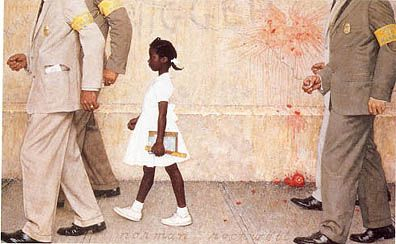by Naja and Arnaud Girard
It’s 7:30 am at the bus stop on Truman and Emma. Eleven-year old Dimitri is about to climb into the morning school bus. Like him, most of the kids sitting on the bus are African American. Like them, he has a mere 40% probability of graduating from high school with his classmates; a stark difference from his white brothers, who have an 83% graduation rate [2013 data].
When we interviewed parents in Bahama Village about this disparity their responses raised an unexpected red flag.
“I didn’t want my son to go to HOB,” says the mother of a fifth grader, “He’s going to the white school.”
BP: “The white school? What do you mean? What white school?”
Mom: “No, it’s just the way we talk. I mean Poinciana.”
BP: “You guys call Poinciana the white school?”
Mom: “Well, yes.”
So, what are they talking about? Is it just a matter of perception or has Key West somehow re-segregated its school system?
This morning we are following the orange bus on its way to Gerald Adams Elementary School on Stock Island. The bus stops in front of one public housing “project” after another: Porter Place, George Allen Apartments, Fort Street Apartments. By the time it parks in front of Gerald Adams, behind 4 other orange school buses, a large majority of the young children pouring out with their backpacks and new clothes are either black or Hispanic. Of the 545 students at Gerald Adams only 141 are white [non-Hispanic].
On their long journey to school however these kids have passed three other elementary schools without stopping: Sigsbee with 508 students, where only 7% of students are black. Montessori with less than 2% blacks. Strangely enough, the third school, Poinciana Elementary [like Sigsbee and Montessori which are Charter schools] has no school buses. Parents must drive their children to school and many students are “out of district,“ enrolled in the school by choice after being placed on a waiting list.
“Well this is the best school,” the crossing guard tells us as we stand on the sidewalk watching the traffic.
“Why aren’t there any school buses?” we ask.
“I don’t know,” says the man.
“But the kids from Bahama Village are being bused all the way to Stock Island.”
“Ah, you noticed that,” says the man who is African American and he adds with a smile, “I have no comment.”
Sixty years ago the Supreme Court, in Brown v Board of Education, unanimously declared segregation in schools a violation of the equal protection clause of the U.S. Constitution. Segregation “generates a feeling of inferiority as to their [minority students] status in the community that may affect their hearts and minds in a way unlikely ever to be undone,” wrote Supreme Court Chief Justice Earl Warren.
We decided to look into the issue of racial integration in Key West schools. What we learned is that segregation in Key West is less an ugly beast breaking through the door than a pervasive old stench creeping back out of the walls. It is done, so to speak, in our sleep by simply not questioning a myriad of innocuous practices, which ultimately happen to result in serving the old prejudices.
So here is the Monroe County secret road-map to re-segregation; the tricks of the trade.
THE BUS ROUTE TRICK
According to Patrick Lefere, who is in charge of school transportation, school buses don’t stop at Poinciana because the district border around the school doesn’t extend past the statutory two mile requirement for bus service.
For segregation watch-dogs, it is precisely the geographic design of those districts which is suspect. The fact is, school buses basically round up kids from all the public housing “projects” and the Bahama Village neighborhood and ship them all to Stock Island [Gerald Adams] or to HOB. Those two schools teach a completely disproportionate percentage of “minority” and low-income students.
THE CHARTER SCHOOL TRICK
When the Florida legislature adopted the 1996 statute allowing public schools to be formed as “charter schools” the goal was to foster “innovative teaching methods”. Privately run charter schools are still considered public schools and are fully funded with taxpayer money. As to their pioneering innovative methods, critics say they are often limited to being magnets for white students moving out of integrated schools.
Sigsbee Elementary became a charter school in 2011 and now has 508 students enrolled. 340 of them are white [non-Hispanic]. Sigsbee alone has more white students than Gerald Adams and HOB Elementary combined.
A teacher we talked to at Gerald Adams Elementary, who asked to remain anonymous, seemed to have no illusions about charter schools:
Teacher: “I’ll give you one fact. We have an average of 100 students entering pre-K at Gerald Adams each year but this year our 5th grade class has only 49 students. Where do you think they all went?”
BP: “I don’t know. You tell me.”
Teacher: “They went to Sigsbee. Sigsbee is actively recruiting our best students. They take the cream of the crop.”
He couldn’t explain how this active recruiting takes place, only that he’d heard it from parents. He blames Gerald Adams slowly dropping from an “A” school in 2012 to a “C” [nearly a “D”] school last year [2014] on the steady exodus of the school’s high academic achievers to Sigsbee Charter School.
“There’s no miracle,” he said, “If our school is left with a high percentage of children with special needs, children for who English is a second language, and all the best students move to charter schools, the overall grade for the school is going to drop.“
Sigsbee Charter School is not only racially unbalanced, it also receives more money than the other public schools. In addition to a $ 325,000 grant when it first opened, the school obtained a $ 570,000 grant in 2012, which it used for the creation of a state of the art science program. Charter schools are also more likely to receive substantial donations from a higher number of affluent parents. While only 3% of Sigsbee students were eligible for free or reduced lunch last year, HOB and Gerald Adams were at 68% at 75%. Arguably some charter schools manage to be not only separate, but also unequal.
THE STUDENT TRACKING TRICK
In sixth grade most Key West students are re-concentrated into one school – HOB Middle School. This is when “teams” and “honors” classes are introduced.
The creation of an “honors” track and a “regular” track results in a school comprised of two parallel universes, where African American students are almost totally absent from “honors classes”.
In recent years student academic tracking has become very controversial throughout the country. One debate made the news when the principal and two assistants [at Gilroy High in California] resigned in protest over the school board’s decision to introduce honors classes. Principal Wendy Gudaluwics was concerned that Hispanic students wouldn’t enroll in honors classes even if they could do the work because their parents might not be aware the classes exist and wouldn’t push their children to take them.
Her concern fits to a tee the honors enrollment process used in Monroe County. The following is a quote from MCSD’s report to the State on the status of equality in education in Monroe County schools:
“Through academic counsel with students and parents, 9th through 12 graders are enrolled in Honors courses.”
In such a system, the amount of family support a child has is clearly a determining factor. Many minority and low-income students, like some in Bahama Village, whose families may have been torn apart by poverty or have issues with the justice system, are at a huge disadvantage.
It gets worse:
We previously reported on an alarming tendency of at least one Key West High School guidance counselor to push white students toward an honors track while blocking black students.
“We each went to see the same guidance counselor with our moms, the same week,” Naomi told us. “Bhajan was put in honors classes, but I was told I could absolutely not take honors classes.“
 Our video interview of Naomi and Bhajan shows two teenagers who grew up together living on boats anchored behind Wisteria Island. Neither had gone to school before or had kept any home-school records. Neither had been tested in any way. The only difference between them was Bhajan was a white boy and Naomi was a half-black girl.
Our video interview of Naomi and Bhajan shows two teenagers who grew up together living on boats anchored behind Wisteria Island. Neither had gone to school before or had kept any home-school records. Neither had been tested in any way. The only difference between them was Bhajan was a white boy and Naomi was a half-black girl.
“He got all the honors classes he wanted and I had to take a remedial class!” says Naomi, “I was bored to death. My first essay was about Halloween. I thought it was pretty good. The teacher gave me a C because she said she believed it had been plagiarized!”
At this point, no one is going to convince Naomi that she has not been the victim of racism. We recommend you don’t even try.
An isolated incident or a systemic problem?
The numbers speak for themselves: In 2013 black and white students were graduating from Gerald Adams with almost identical FCAT reading scores [65% of blacks and 66% of whites were proficient in reading].
However, the information we’ve received from current students tells us there are as few as 3% black students to none at all in most of the honors classes. Enrollment in honors classes is discretional, there is no clear prerequisite, and it escapes outside control because the enrollment lists are confidential.
No one can know for sure how many Naomi’s in Monroe County’s school system are floating in the pool of disillusionment and broken dreams, performing precisely to the low level expected by a system which has seemingly given up on them.
“Regular Classes”: Code for Substandard Minority Classes?
The issue of “honors classes” vs. “regular classes” is not about whether the “honors” academic standards are too high, but whether they are in fact too low.
All of the teachers, parents, and students we have interviewed over the past month seem to be convinced that the “honors classes” are in fact regular classes. Which would mean that the so-called “regular classes” are in fact substandard classes.
Because they are wrongly identified as “regular” classes, “the system” can sit back and relax when in fact administrators should declare a state of emergency in those “regular classes” and send a remedial cavalry to the rescue.
Low expectations rather than rescue efforts seem to be the common denominator for “regular classes.”
“In fact, it totally depends on the teacher,” said one student who recalls having had a geography teacher, Mr. Eggers, who completely turned his “regular” class full of “problem” students into a “very motivated group.”
BP: “How did he do that?”
Student: “I don’t know. I think he was just asking more of everybody.”
“Random” Team Assignments Based on Cultural Choices
Another suspected tracking method is the assignment of students into two separate “teams” when they enter HOB Middle School. According to school administrators, assignments to the “A” team or the “B” team are completely random. It’s just a fluke that the “A” team has nearly all of the top honor roll students and the “B” team has the bulk of students with the lowest test scores. Some parents are not convinced.
“Look,” said one parent, “It’s simple, the “A” team has all of the band students and the “B” team has the P.E. students. You can’t be in both. If you’re a kid from Bahama Village, playing the Oboe or the French Horn for hours at band practice might not seem all that attractive. You want to play football so you end up on the “B” team and that’s one of the ways they manage to separate these kids.”
One last thing:
No Black Teachers
Many studies on school segregation and closing the racial academic achievement gap stress the importance of same race role models. But when it comes to black students, the reality is that Monroe County School District has almost no African American teachers. There are 486 white [non-Hispanic] teachers, 78 Hispanic and only 5 black teachers [2013].
With a Masters Degree in Political Science and a teaching degree, Bahama Village resident Sonny Reves was once a black man trying to get a job teaching in Monroe County’s public school system. “I always wanted to teach,” he told us, “I finally managed to get a job in a special grant program. It was an extra-curricular educational program, but when the grants were terminated after six years, we all hoped we would be transferred over to the public school system. I was the only black teacher in the group and the only one who was not hired.” Sonny recently retired as a cable TV installer for Comcast, never having managed to get hired as a teacher again. “And I tried,” he said shrugging his shoulders.
How to Fix It
“We used to all be friends when we were in elementary school. Then you get to middle school and everything seems to change,” laments one student.
School Board member Andy Griffith is well acquainted with the problem:
“Reform demands competition. Charter schools and corporate vouchers come on the scene offering parents a choice. Parents who are involved in their children’s education make the best partners in order to educate children. Choice results in involved families leaving the conventional schools. Our minority schools in Key West have 79% free and reduced lunch [an indicator of poverty] and our charter schools have 7%. Some competition. But choice is good right? Well choice results in segregated schools in a small community. But segregation is bad right? Yes, it is but we can’t seem to find the answer to having both.”
Our question is this:
How hard would it be to hire more black teachers? To redraw the districts and bus routes so as to balance the racial diversity of the elementary schools?
Certainly, the charter schools should be required to take care of their fair share of social and constitutional obligations. Under Florida Statue 1002.33(7)(8), charter schools must actively pursue efforts to mirror the racial mix of the community and the school board has the power to close the doors when they fail to do so.
Finally, we should stop pretending that the non-honors classes are “regular” classes, admit that those classes are producing substandard results, and make immediate efforts to bring those students up to speed and do so until racial tracking has become irrelevant.


Sorry, the comment form is closed at this time.